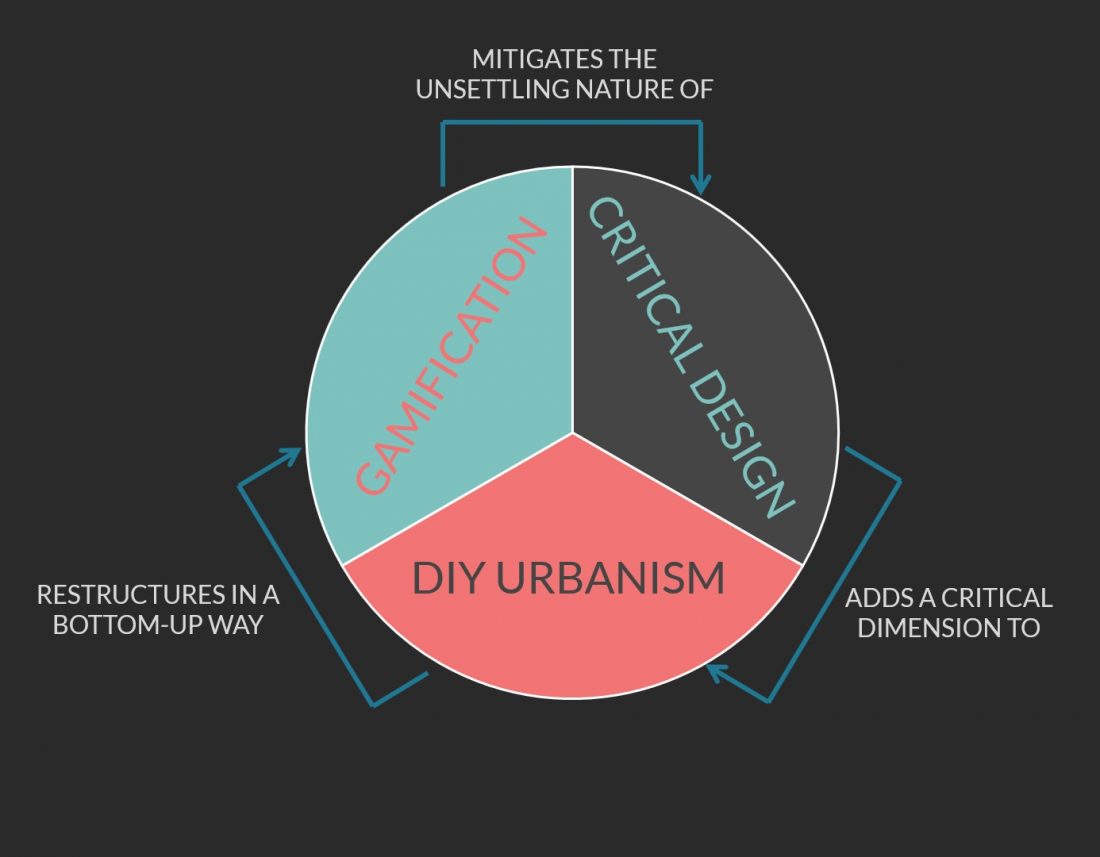
Critical Playable Cities
Cities are spaces permeated by constant tension and conflict, as inhabitants define and redefine them, while going about their daily living. Citizens, institutions, governments and businesses all compete for the possibility of writing the city, of modifying its forms and uses, of engraving themselves in the urban fabric. It is a quiet conflict, petrified in the city buildings and streets, fought in the everyday use of the urban spaces. Playable Cities [1] proposes to ease these struggles by hacking the technology of smart cities and using it to create stronger and healthier communities of citizens. But what if we tried to go one step further? Can playfulness be a way of dealing with these tensions, channelling the struggles of urban living into creative practices instead of destructive ones?
To this end, we propose a new framework for critical playable cities, that adds to the urban and playful components a critical dimension. This framework, more precisely, is built around three elements:
1) DIY Urbanism, a term that indicates the citizens’ actions to reclaim and modify the urban spaces in a bottom up, grassroot way;
2) Critical design, which revolves around the idea that, instead of reinforcing the status quo, design should challenge it by allowing new speculative scenarios that question our thinking and habits;
3) Gamification, and in particular, urban gamification, consisting in introducing playfulness to urban contexts that are, traditionally, considered “serious”. When hosting playful activities, urban spaces are gamified, that is, they are (briefly) transformed to playgrounds, that systematically change the perceptions, actions and interactions of the citizens involved in the activities with the city [2].
Drawing from these three elements, we built a framework for critical playable cities, consisting in using the qualities of play (it being safe, engaging, intrinsically motivated and involving make-believe) in actions of city re-appropriation that encourage critical thinking. The resulting actions are to be bottom-up, creative and playful urban co-productions that challenge the status quo. The key feature of our framework is that its three components – DIY urbanism, critical design and urban gamification – when working in synergy, overcome the issues that they sometimes raise if applied singularly (See featured image).
This framework offers a toolbox to understand and eventually design and implement actions of urban gamification. These actions are able to reappropriate city spaces while avoiding to be openly confrontational and hostile to city officials and law enforcement. This does not diminish the social and political relevance of their battle: at the contrary, it makes them useful tools for fighting for the right to city for two reasons. On the one hand, because they are used to criticise the top-down decisions of the municipalities and to propose bottom-up, grassroot alternative agendas. On the other hand, because their very implementation is already a way of modifying urban life, of reshaping the interactions between citizens and between active players and passers-by.
Critical Playabe Cities
Lobna Hassan & Mattia Thibault
Reference: Hassan L., Thibault M. (2019) Critical Playable Cities. In: Nijholt A. (eds) Making Smart Cities More Playable. Gaming Media and Social Effects. Springer, Singapore
See the paper for full details:
Abstract
This chapter outlines a specific framework for the creation of critical playable cities. This framework combines three different concepts: DIY urbanism, critical design and urban gamification which are seen as complementary to each other. Cities are complex systems. Various actors often explicitly or implicitly harmonize or collide to shape the landscape of a city and its future. In the past decades, there has been an increased interest in activating citizens as vital actors in shaping urban life. This has taken place through various practical works and research around the paradigms of Playable Cities, DIY Urbanism and Gamification amongst other paradigms. Urban gamification—that is, using play and playfulness to alter our perception of and interactions with city spaces—is specifically emerging as one of the main strategies to activate citizens. Urban gamification alone, however, risks to be disconnected from the urban fabric and its communities. In this chapter we argue that combining it with the grassroot approach of DIY urbanism and the thought-provoking techniques of critical design creates a unique, multi-dimensional approach to designing urban experiences. This chapter, then, aims to explore how play can be used by citizens as a mean for critical reflection and practical re-appropriation of public urban spaces.
References:
[1] Nijholt A (2017) Playable Cities the City as a Digital Playground. Springer. doi.org/10.1007/978-981-10-1962-3_1[2] Thibault M (2019) Re-interpreting Cities with Play Urban Semiotics and Gamification. Springer, Cham pp 276–285. doi.org/10.1007/978-3-030-06134-0_32
Acknowledgments:
This project has received funding from the European Union’s Horizon 2020 research and innovation programme under the Marie Sklodowska-Curie grant agreement No 793835.
This work was also supported by the Finnish Foundation for Economic Education (grants: 12-6385 and 14-7824), and the Finnish Cultural Foundation (grant: 00190298).




Sorry, the comment form is closed at this time.